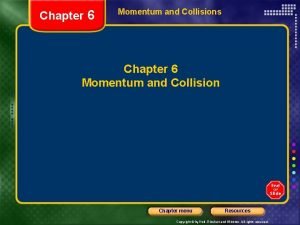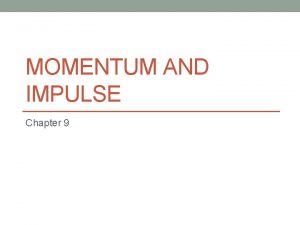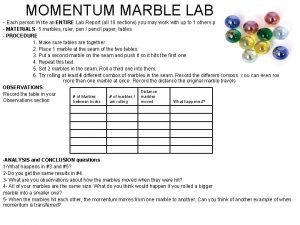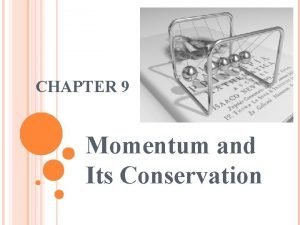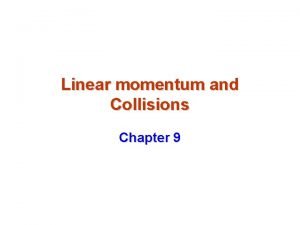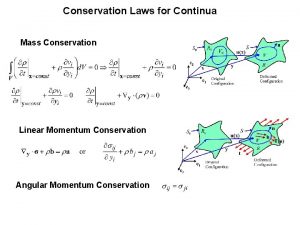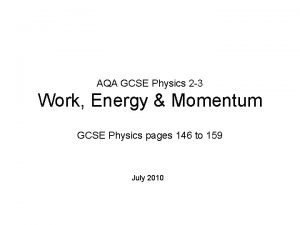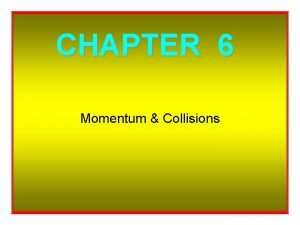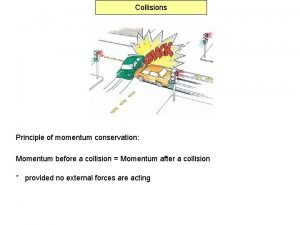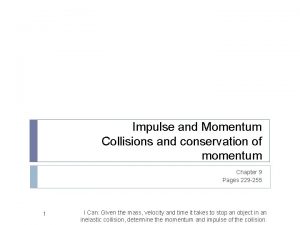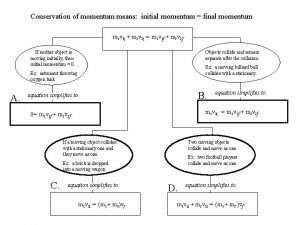Conservation of Momentum Elliott Collisions The total momentum

















- Slides: 17

Conservation of Momentum Elliott

Collisions The total momentum of a system remains constant provided that no external forces act on the system. total momentum before = total momentum after

Total Momentum • The system may consist of several elements, each of which has its own momentum. • The total momentum is the sum of all these different momenta. As long as the total momentum remains the same, momentum can be shared out differently between each element. • In other words, each body can exchange momentum with the other bodies, and get a different share, as long as the total momentum stays the same.

Model – Dodgems The total momentum of a system remains constant provided that no external forces act on the system. Each car has the same mass, but we can imagine them having different velocities.

Check Your Progress • The total momentum of a system remains constant provided that no external forces act on the system. What do you understand by the statement above?

Answer • The different momenta will have different values and different directions. When these are summed, they add up to zero.

Collisions Momentum is always conserved in collisions. If objects bounce off each other, the collision is elastic. If the total kinetic energy is the same (conserved) at the end as it is at the start, then the collision is perfectly elastic. If some kinetic energy is lost, converted into heat or light, then the collision is inelastic.

Conservation of Momentum Total momentum before = total momentum after Total energy before = total energy after Mu 1 + mu 2 = Mv 1 + mv 2 The term E is the energy that is lost in the collision. In a perfectly elastic collision E = 0.

Check Your Progress The diagram shows two cars at a fairground, before and after bumping into each other. (a) What is (i) the total kinetic energy before the collision; (ii) the total kinetic energy after the collision. (iii) the total loss in kinetic energy. (b) Is this an elastic collision? Explain your answer.

Answer

Check Your Progress • What is the speed of the 500 kg car after the collision?

Answer Momentum before = momentum after Momentum before = m 1 u 1 + m 2 u 2 Momentum before = (500 kg x 5. 0 m s-1) + (400 kg x 2. 0 m s-1) Momentum before = 2500 kg m s-1 + 800 kg m s-1 = 3300 kg m s-

Check Your Progress A bullet of mass 45 g is travelling horizontally at 400 m/s when it strikes a wooden block of mass 16 kg suspended on a string so that it can swing freely. The bullet is embedded in the block. Calculate: a) The velocity at which the block begins to swing; b) The height to which the block rises above its initial position; c) How much of the bullet’s kinetic energy is converted to internal energy.

Answer (a) The velocity at which the block begins to swing; Momentum before = momentum after Momentum before = m 1 u 1 + 0 Momentum before = (0. 045 kg x 400 m s-1) + (0) Momentum before = 18 kg m s-1 Momentum after = total mass of bullet and wood x speed Momentum after = (16. 000 kg + 0. 045 kg) x v m s-1 Momentum after = 16. 045 v kg m s-1 Therefore: 16. 045 v kg m s-1 = 18 kg m s-1 v = 18 kg m s-1 ÷ 16. 045 = 1. 12 m s-1

Answer (b)

Answer (c) How much of the bullet’s kinetic energy is converted to internal energy. We need to know the kinetic energy of the bullet: Ek = 1/2 mv 2 = 1/2 x 0. 045 kg x (400 m s-1)2 = 3600 J Now we need to know the kinetic energy of the block and bullet: Ek = 1/2 x 16. 045 kg x (1. 12 m s-1)2 = 10. 1 J Kinetic energy lost = 3600 J - 10. 1 J = 3590 J This energy is not destroyed, but converted into internal energy.

 Perfect inelastic collision
Perfect inelastic collision Momentum is conserved in all collisions
Momentum is conserved in all collisions A 1850 kg luxury sedan stopped
A 1850 kg luxury sedan stopped Chapter 6 momentum
Chapter 6 momentum A roller coaster climbs up a hill at 4m/s and then
A roller coaster climbs up a hill at 4m/s and then Momentum conservation equation
Momentum conservation equation Momentum practice problems
Momentum practice problems Marble momentum lab
Marble momentum lab A baseball player holds a bat loosely
A baseball player holds a bat loosely Angular momentum right hand rule
Angular momentum right hand rule Conservation of momentum
Conservation of momentum A 1875 kg car going 23 m/s
A 1875 kg car going 23 m/s State the principle of conservation of momentum
State the principle of conservation of momentum Momentum conservation law
Momentum conservation law Combined velocity after collision formula
Combined velocity after collision formula Conservation of linear momentum
Conservation of linear momentum Conservation of momentum bbc bitesize
Conservation of momentum bbc bitesize Momentum conservation level 1
Momentum conservation level 1



